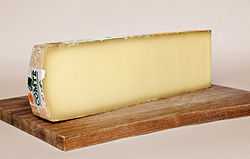Comté cheese
| Comté | |
|---|---|
 | |
| Country of origin | France |
| Region, town | Franche-Comté |
| Source of milk | Cows |
| Pasteurised | No |
| Texture | semi-hard |
| Aging time | 8-12 months |
| Certification | French AOC 1958 |
Comté (also called Gruyère de Comté) (French pronunciation: [kɔ̃.te]) is a French cheese made from unpasteurized cow's milk in the Franche-Comté region of eastern France. Comté has the highest production of all French AOC cheeses, around 40,000 tonnes annually.
The cheese is made in flat circular discs, each between 40 centimetres (16 in) and 70 centimetres (28 in) in diameter, and around 10 centimetres (4 in) in height. Each disc weighs up to 50 kilograms (110 lb) with an FDM around 45%. The rind is usually a dusty-brown colour, and the internal pâte is a pale creamy yellow. The texture is relatively hard and flexible, and the taste is strong and slightly sweet.
History
The manufacture of the cheese began as early as the 12th century, when shepherds would spend the summer months in their remote huts of the Jura massif. The distance from towns of any size meant that any cheese they made would need to mature over a period of months. The milk was pooled between neighbouring shepherds, and the huge cheeses would be stored until being carried to market at the end of the season.
Once summer had ended, so would production of Comté, with the cows' milk instead being used to make Vacherin Mont d'Or.
Eight départements are now entitled to produce the cheese, each of which surrounds Franche-Comté, and also including parts of Rhône-Alpes.
Production
Fresh from the farm, milk is poured into large copper vats where it is gently warmed. Each cheese requires up to 600 litres (160 US gal) of milk. Rennet is added, causing the milk to coagulate. The curds are then cut into tiny white grains that are the size of rice or wheat which are then stirred before being heated again for around 30 minutes. The contents are then placed into moulds and the whey is pressed out. After several hours the mould is opened and left to mature in cellars, first for a few weeks at the dairy, and then over several months elsewhere.
The manufacture of Comté has been controlled by AOC regulations since it became one of the first cheeses to receive AOC recognition in 1958, with full regulations introduced in 1976. The AOC regulations for Comté prescribe:[citation needed] [1]
- Only milk from Montbeliarde Cattle or French simmental (or cross breeds of the two) are permitted, and each must have at least a hectare of grazing.
- Fertilization is limited, and cows may only be fed fresh, natural feed, with no silage.
- The milk must be transported to the site of production immediately after milking.
- Renneting must be carried out within a stipulated time after milking, according to the storage temperature of the cheese.
- Only one heating of the milk may occur, and that must be during renneting. It may be heated to no more than 40˚C.
- Salt may only be applied directly to the surface of the cheese.
- A casein label containing the date of production must be attached to the side of the cheese, and maturing must continue for at least four months.
- No grated cheese may be sold under the Comté name.
In 2005 the French Government registered 175 producers and 188 affineurs (agers) in France [2]
Grading
Each cheese is awarded a score out of 20 by inspectors, according to 'overall appearance' (1 mark), 'quality of rind' (1.5), 'internal appearance' (3.5), 'texture' (5), and taste (9). Those scoring 15 or above are given a green casein label with the characteristic image of a green bell and may be called 'Comté extra', with 12-15 being given a brown label and simply called 'Comté'. Any cheese scoring under 3 marks for taste, or under 12 overall is prohibited from being named Comté and is sold as Gruyère in France.[3]

Aging time
Most Comté cheeses are aged from 12 to 18 months, though some are aged as little as four months and as long as 24 months.[4] Some places, especially high-class restaurants, can carry Comtés aged for a longer time. The restaurant L'Arpège in Paris, France, is known to carry a four-year-old Comté.[citation needed]
References
External links
| Wikimedia Commons has media related to Comté (cheese). |